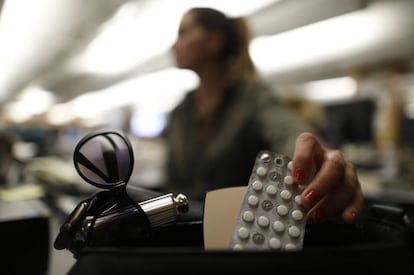Spaniards abuse painkillers: EU survey
A survey of 22,000 Europeans revealed questionable use of prescription drugs

Danilo González has been taking Rubifen for a few weeks, a drug used on children with an attention deficit and hyperactivity. But Danilo (not his real name) is not a child, does not have attention deficit disorder or hyperactivity. “Rubifen gives you a high and makes you more lucid. It’s like taking cocaine but less harmful in general,” explains the thirty-something Spaniard.
He is one of hundreds of thousands of people inappropriately taking prescription drugs in Spain, a mix of opioids, tranquilizers and stimulants whose abuse is already a problem in the US and is fast becoming one in the EU.
A survey of 22,000 people between the ages of 12 and 49 in five European countries showed the extent of the abuse. Spain was seen to be the biggest consumer of opioids with 18% of those questioned admitting to taking the drug at some point during their lives and almost 7% doing so in the last year.
Abuse of prescription drugs is already a problem in the US and is fast becoming one in the EU
Opioids are painkillers such as tramadol and codeine. Its abuse usually happens when someone in pain gets a hold of them through a friend and starts to self-medicate, but they are also used as a party drug. “Codeine and tramadol are considered chic in Russia,” says José Martínez Raga, one of the co-authors of the study and psychiatrist at Valencia’s Doctor Peset University. “An overdose produces a stimulating effect.”
Spain is also leading in the consumption of sedatives such as alprazolam – sold commercially as Trankimazin, lorazepam – Orfidal, diazepam – Valium and bromazepam –Lexatin. “Some people mix them with cocaine or alcohol,” says Martínez. “They’re most commonly used by cocaine addicts.”
As many as 18% of those surveyed admit to have taken one or all of these drugs without a prescription at some time in their life and more than 9% have done so in the last year. The improper use of prescription drugs is as much to do with self-medication as using them to get high.
Psychiatrist José Martínez Raga.
The new study comes out today in the magazine, BMC Psychiatry, with data from the UK, Germany, Denmark and Sweden as well as Spain. Britain heads the abuse of stimulants such as Rubifen, which is primarily used to aid concentration during exams. 9% of Brits admitted to taking stimulants at some point in their lives while 4% have done so in the past year against 6.8% and 2.4% of Spaniards, respectively.
“There is a lot of research on the phenomenon in the US but it hasn’t been investigated in Spain and the rest of Europe until now,” says Martínez who has calculated that across all five countries surveyed, 13.5% have used opioids at some point in their lives while 5% have done so in the last year; 11% have used tranquillizers at some point and 6% in the last year; and 7% have used stimulants at some stage with 3% using in the last year. This new research is headed by Scott Novak of RTI International, a NGO in the US where the number of people taking one or all of these drugs at some point rises to 20%.
Whether or not people abuse these drugs seems to have as much to do with where they live as their genetic make up. Novak’s team points out that the practice is more common among non-whites and the unemployed. Obviously, if you have ever been officially prescribed one of these medicines, you are more likely to abuse them – ten times more when it comes to tranquillizers, eight times more in the case of opioids and seven times more with stimulants. This abuse of prescription drugs is also known as an iatrogenic addiction.
Sign up for our newsletter
EL PAÍS English Edition has launched a weekly newsletter. Sign up today to receive a selection of our best stories in your inbox every Saturday morning. For full details about how to subscribe, click here
“In Spain, the use of prescription drugs is taken lightly,” says Martínez, hoping to get the message across to national health services. “In Spanish TV series, they talk about taking Orfidal and Trankimazin as if they were candy. In drug campaigns, they should include not only alcohol and tobacco but also prescription drugs. Teenage years are crucial. And here we are seeing the problem starting in children.”
English version by Heather Galloway.
Tu suscripción se está usando en otro dispositivo
¿Quieres añadir otro usuario a tu suscripción?
Si continúas leyendo en este dispositivo, no se podrá leer en el otro.
FlechaTu suscripción se está usando en otro dispositivo y solo puedes acceder a EL PAÍS desde un dispositivo a la vez.
Si quieres compartir tu cuenta, cambia tu suscripción a la modalidad Premium, así podrás añadir otro usuario. Cada uno accederá con su propia cuenta de email, lo que os permitirá personalizar vuestra experiencia en EL PAÍS.
¿Tienes una suscripción de empresa? Accede aquí para contratar más cuentas.
En el caso de no saber quién está usando tu cuenta, te recomendamos cambiar tu contraseña aquí.
Si decides continuar compartiendo tu cuenta, este mensaje se mostrará en tu dispositivo y en el de la otra persona que está usando tu cuenta de forma indefinida, afectando a tu experiencia de lectura. Puedes consultar aquí los términos y condiciones de la suscripción digital.
More information
Últimas noticias
Maduro pleads not guilty before the federal court in New York: ‘I am still the president of Venezuela’
A new test can detect Alzheimer’s from a finger prick
UN team enters Sudanese city of El Fasher after paramilitary massacre: ‘It’s like a ghost town’
A recipe for resistance: Indigenous peoples politicize their struggles from the kitchen
Most viewed
- Gilles Lipovetsky: ‘If you want to live better and fall in love, take Prozac, don’t look to philosophy’
- Alain Aspect, Nobel laureate in physics: ‘Einstein was so smart that he would have had to recognize quantum entanglement’
- Maduro’s downfall puts China’s relationship with Venezuela to the test
- Why oil has been at the center of Venezuela-US conflicts for decades
- Alvin Hellerstein, a 92-year-old judge appointed by Bill Clinton, to preside over Maduro’s trial in New York











































